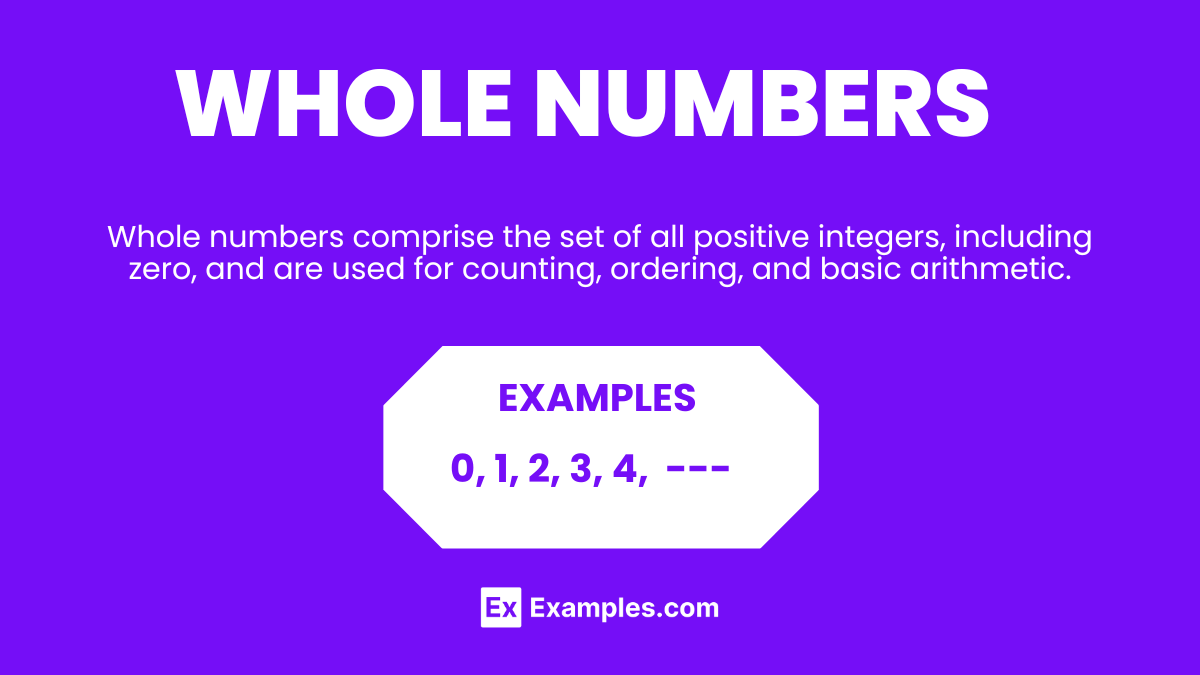What is the result of adding 123 and 456?
579
576
489
389

Whole Numbers an essential pillar of mathematics. This guide is tailored for educators and students, offering clear, concise explanations accompanied by practical examples. Whole numbers, including zero and all positive integers, are fundamental in understanding and applying various mathematical operations and concepts. By demystifying these basics, this guide aims to build a solid foundation, enhancing mathematical literacy and communication. Ideal for classroom instruction, it empowers teachers to convey concepts effectively and students to grasp and apply them confidently.
Whole numbers comprise the set of all positive integers, including zero, and are used for counting, ordering, and basic arithmetic. Unlike natural numbers, which start from one, whole numbers include zero, making them a crucial concept in mathematics. This simple yet fundamental distinction expands their application, facilitating a deeper understanding of mathematical operations and the number system. Ideal for educational settings, whole numbers help bridge the gap between abstract concepts and real-world application, providing a foundation for advancing mathematical knowledge and skills.
The set of whole numbers is a foundational concept in mathematics, encompassing all positive integers along with zero. This inclusive set forms the basis for arithmetic operations and mathematical reasoning. By understanding the set of whole numbers, students gain insight into the structure of mathematics, enabling them to perform basic calculations and develop logical thinking skills. For educators, teaching this concept is pivotal in preparing students for more complex mathematical challenges, enhancing their ability to navigate the numerical world.
The symbol for whole numbers, typically represented by the letter W or ℕ₀, plays a critical role in mathematical notation and communication. It provides a concise way to refer to the set of all non-negative integers, including zero, facilitating clearer understanding and discussion of mathematical concepts. By incorporating this symbol into mathematical discourse, educators and students can efficiently express and explore the properties and operations associated with whole numbers, enhancing their numerical literacy.
The smallest whole number is zero (0), a fundamental concept in mathematics that represents the absence of quantity. It marks the beginning of the set of whole numbers and is pivotal in understanding numerical operations, the concept of nullity, and the foundation of various mathematical principles. Zero’s inclusion as a whole number is essential for arithmetic operations, algebra, and the broader understanding of the number system, making it a critical teaching point for educators aiming to impart a comprehensive mathematical education.
| Aspect | Natural Numbers | Whole Numbers |
|---|---|---|
| Starting Number | 1 | 0 |
| Inclusivity of 0 | No | Yes |
| Use | Counting, ordering objects | Counting, including scenarios where ‘none’ is a concept |
| Set Notation | {1, 2, 3, …} | {0, 1, 2, 3, …} |
| Mathematical Role | Fundamental in basic arithmetic operations excluding zero | Extends natural numbers by including zero |
Positioning whole numbers on a number line visually represents their order and magnitude, providing a tangible way to understand numerical relationships. This linear model aids in comprehending addition, subtraction, and the concept of distance between numbers. For educators, using a number line as a teaching tool enhances students’ ability to visualize and internalize mathematical principles, facilitating a deeper grasp of arithmetic and number theory.
Whole numbers possess distinct properties that are pivotal in arithmetic and algebra, including closure, commutativity, associativity, identity, and distributivity. Understanding these properties is essential for mathematical reasoning and problem-solving, serving as the cornerstone for more complex mathematical operations and theories. For students and educators, these properties clarify the behavior of whole numbers under various operations, enhancing their ability to manipulate and apply numbers effectively.
No, whole numbers cannot be negative. They consist of zero and all positive integers, starting from zero onwards without any fractional or decimal components.
Yes, 10 is a whole number. It represents a positive integer on the number line, including zero, and fits within the definition of whole numbers.
Fractions, decimals, and negative integers are not whole numbers. Whole numbers include only zero and the positive integers without any fractional or decimal parts.
Yes, all whole numbers are real numbers. They are a specific subset of real numbers that include zero and positive integers, situated on the number line.
All natural numbers are whole numbers, except for zero. Natural numbers start from 1, whereas whole numbers include zero in addition to all natural numbers.
Yes, natural numbers and counting numbers are the same, both starting from 1 and used for counting objects, excluding zero.
In summary, whole numbers form a critical component of mathematics, embodying zero and all positive integers. They are foundational for understanding arithmetic operations, setting the stage for more complex mathematical concepts. Through their properties and the distinctions from other number types, whole numbers play a crucial role in educational contexts, aiding teachers in clarifying key mathematical principles for students.
Text prompt
Add Tone
Smallest Whole Number
Difference Between Natural Numbers and Whole Numbers
What is the result of adding 123 and 456?
579
576
489
389
Which of the following is a whole number?
-7
0
3.5
2.7
What is the result of subtracting 65 from 200?
135
145
125
135
Which of the following numbers is not a whole number?
15
0
-5
23
What is the result of adding 7 and 8?
13
15
16
17
What is the smallest whole number greater than 10?
9
10
11
12
If you subtract 5 from 14, what is the result?
8
9
7
6
Which of the following numbers is a multiple of 6?
16
18
20
22
What is the sum of the first five whole numbers (0, 1, 2, 3, 4)?
10
12
15
20
What is the largest whole number less than 30?
28
29
30
31
Before you leave, take our quick quiz to enhance your learning!

